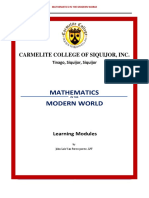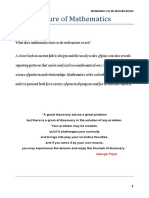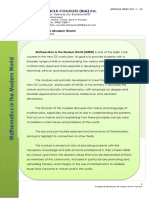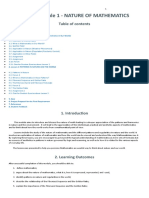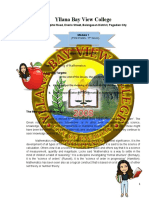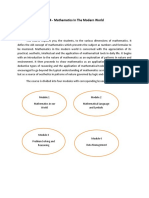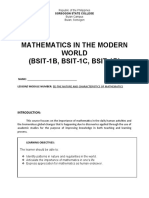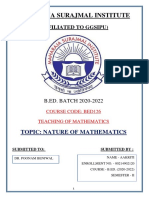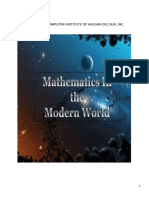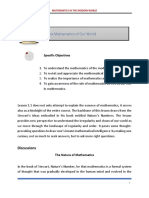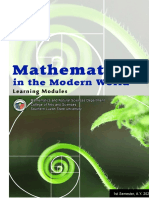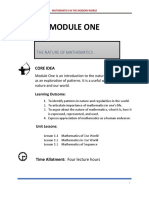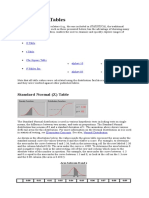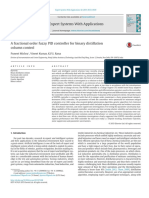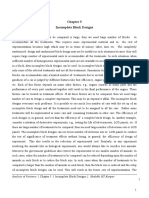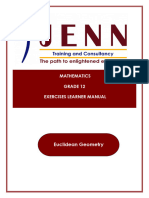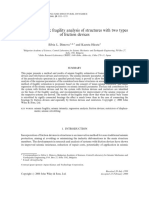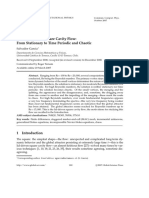Activity 1-Math 101
Uploaded by
Brent CamutaActivity 1-Math 101
Uploaded by
Brent CamutaHOLY CROSS OF DAVAO COLLEGE, INC.
A.Y. 2022-2023/1st Semester
MATHEMATICS IN THE MODERN WORLD
Name:__________________________________ Date:_______________
ACTIVITY NO. 1
Read first the content for the enrichment of your activity. Please be guided accordingly.
Introduction: Nature of Mathematics
Mathematics may be viewed from different perspectives. In its wildest significance, it is the
development of all types of formal deductive reasoning. Generally, it is said to be the science of
calculation. Others view it as a science of numbers and space, and others say it is a science of
measurement, quantity, and magnitude. Locke said, “Mathematics is a way to settle in the mind
of children a habit of reasoning.” It is a discipline investigating “formal structures” (Bernays), it is
the “science of orders” (Russell), it is the “science of order in progression” (Hamilton).
Mathematics has also been seen as a logical construct based on many axioms of either set
theory or number theory.
Traditionally, mathematics is presented deductively at school. And is often perceived as well
structured, and problems are algorithmically approached. Merriam dictionary defines
mathematics as the science of numbers and their operations, interrelations, combinations,
generalizations, abstractions, and space configurations of their structure, measurement,
transformations, and generalizations.
Mathematics is derived from the ancient word manthanein meaning "to learn." The Greek root
mathesis means "knowledge" or its other form máthema meaning science, knowledge, or
learning, and mathematikós or mathemata means "fond of learning." These might have been
the notion of the early mathematicians and philosophers that is why they continue to seek
knowledge and the truth. Mathematics could then be defined as a desire for a particular kind of
knowing. Knowing that is self-contained on the individual or may be seen as autonomous
thinking (Schaaf, 1963). Mathematics is described in so many ways that it fits within the area of
human knowledge. Basically, it is seen as a study of patterns and relations. It is also a way of
thinking. Mathematics is seen as an art that is characterized by order and internal consistency.
It is a language that uses carefully defined terms and symbols. Thus, mathematics is a tool
(Reys, Lindquist, Lambdin, Smith, and Suydam, 2004).
Mathematics is an integral part of daily life; formal and informal. It is used in technology,
business, medicine, natural and data sciences, machine learning and construction. It helps
organize patterns and regularities in the world, predict the behavior of nature and phenomenon
in the world, control nature and occurrences in our world for our end. Mathematics has
numerous applications in the world making it indispensable.
Like any other languages, mathematics has its own symbols, syntax and rules characterized as
precise, concise and powerful mathematical language. It differentiates expression from
sentences. It talks about the conventions in the mathematical language. It gives emphasis on
four basic concepts which are sets, functions, relations and binary operations.
Mathematics is not just numbers but it deals greatly with problem solving and reasoning skills. It
also includes intuition, proof, and certainty. It utilizes Polya’s 4-step in problem solving, varied
problem solving strategies, mathematical problems involving patterns and recreational problems
using mathematics.
Reference: Mathematics in the Modern World by Romeo M. Daligdig, EdD
Task No. 1.
In 150 words, explain the role of Mathematics in your course. (30 pts)
Directions: Submit your output as a single pdf file in the submission bin for this activity in the
Google Classroom.
Criteria:
Writing Mechanics – 20
Grammar and Originality – 10
Total – 30 pts
Prepared by: Mr. Brent B. Camuta, LPT, MA
You might also like
- Mathematics-in-the-Modern-World-Module by CHED90% (10)Mathematics-in-the-Modern-World-Module by CHED444 pages
- Ged 102 Mathematics in The Modern World Module PDF Copy 230116013450 6b28f3d6No ratings yetGed 102 Mathematics in The Modern World Module PDF Copy 230116013450 6b28f3d6341 pages
- Colegio de San Gabriel Arcangel: Britannica Defines Mathematics As "The Science of Structure, Order, andNo ratings yetColegio de San Gabriel Arcangel: Britannica Defines Mathematics As "The Science of Structure, Order, and5 pages
- Mathematics in The Modern World: in Relation To VISION, MISION AND GOALS of The UniversityNo ratings yetMathematics in The Modern World: in Relation To VISION, MISION AND GOALS of The University20 pages
- Yllana Bay View College: East Capitol Road, Enerio Street, Balangasan District, Pagadian CityNo ratings yetYllana Bay View College: East Capitol Road, Enerio Street, Balangasan District, Pagadian City4 pages
- Nature of Mathematics (00214902120) AakritiNo ratings yetNature of Mathematics (00214902120) Aakriti22 pages
- Mathematics in The Modern World PointersNo ratings yetMathematics in The Modern World Pointers16 pages
- Week 1: Mrs. Mirasol Y. Sarmiento TeacherNo ratings yetWeek 1: Mrs. Mirasol Y. Sarmiento Teacher15 pages
- Aims and Objectives of Teaching MathematicsNo ratings yetAims and Objectives of Teaching Mathematics15 pages
- Course Description: MATHEMATICS in The MODERN WORLD First Semester SY 2021 - 2022No ratings yetCourse Description: MATHEMATICS in The MODERN WORLD First Semester SY 2021 - 202270 pages
- Ched Syllabus Mathematics in The Modern World PDF100% (1)Ched Syllabus Mathematics in The Modern World PDF24 pages
- KWF Mathematics in The Modern World PDFNo ratings yetKWF Mathematics in The Modern World PDF24 pages
- Ug B.ed. Education 70123 C - Teaching of Mathematics 9236No ratings yetUg B.ed. Education 70123 C - Teaching of Mathematics 9236277 pages
- Foundations of Mathematical Thought: The Language of Numbers: An In-Depth Exploration of Abstraction, Formal Systems, and Logical ReasoningFrom EverandFoundations of Mathematical Thought: The Language of Numbers: An In-Depth Exploration of Abstraction, Formal Systems, and Logical Reasoning5/5 (1)
- Distribution Tables: Standard Normal (Z) TableNo ratings yetDistribution Tables: Standard Normal (Z) Table13 pages
- MATH 101-WEEK 11-12-STUDENT HANDOUT-Making Sense of MoneyNo ratings yetMATH 101-WEEK 11-12-STUDENT HANDOUT-Making Sense of Money11 pages
- First Course in differential equations (11ed) / Differential Equations and Boundary Value Problems (9ed) Solutions manual Dennis Zill Roberto Martinez - The latest ebook is available for instant download now100% (1)First Course in differential equations (11ed) / Differential Equations and Boundary Value Problems (9ed) Solutions manual Dennis Zill Roberto Martinez - The latest ebook is available for instant download now63 pages
- Analysis of A Methanol/ethanol SeparatorNo ratings yetAnalysis of A Methanol/ethanol Separator17 pages
- Utilizing Python For Neutrosophic Theory: A Study of Neutrosophic Crisp Sets and Topological SpacesNo ratings yetUtilizing Python For Neutrosophic Theory: A Study of Neutrosophic Crisp Sets and Topological Spaces12 pages
- Elementary Differential Equations 11th Edition Boyce Solutions Manual instant download100% (2)Elementary Differential Equations 11th Edition Boyce Solutions Manual instant download70 pages
- Analysis of Variance - Chapter 5 - Incomplete Block Designs - Shalabh, IIT KanpurNo ratings yetAnalysis of Variance - Chapter 5 - Incomplete Block Designs - Shalabh, IIT Kanpur41 pages
- WWW Velaepavio Com Translate Goog Tag Trading System - X - TR - SL Auto - X - TR - TL en - X - TR - HL en US - X - TR - Pto WappNo ratings yetWWW Velaepavio Com Translate Goog Tag Trading System - X - TR - SL Auto - X - TR - TL en - X - TR - HL en US - X - TR - Pto Wapp20 pages
- Algebra of Functions Composition SymmetryNo ratings yetAlgebra of Functions Composition Symmetry9 pages
- (Ebook) Optimization algorithms on matrix manifolds by P.-A. Absil, R. Mahony, R. Sepulchre ISBN 9780691132983, 0691132984 pdf downloadNo ratings yet(Ebook) Optimization algorithms on matrix manifolds by P.-A. Absil, R. Mahony, R. Sepulchre ISBN 9780691132983, 0691132984 pdf download52 pages
- PPS-BTPS-101-18 UNIT-1 2 Marks Question AnswersNo ratings yetPPS-BTPS-101-18 UNIT-1 2 Marks Question Answers3 pages
- Simplified Seismic Fragility Analysis of Structures With Two Types of Friction DevicesNo ratings yetSimplified Seismic Fragility Analysis of Structures With Two Types of Friction Devices23 pages
- Allama Iqbal Open University Islamabad (Department of Business Administration)No ratings yetAllama Iqbal Open University Islamabad (Department of Business Administration)5 pages








